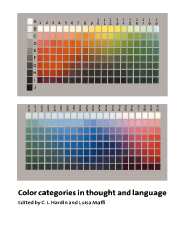Book contents
- Frontmatter
- Contents
- Notes on contributors
- 1 Introduction
- I THE WORLD COLOR SURVEY
- II VISUAL PSYCHOLOGISTS
- 3 The psychophysics of color
- 4 Physiological mechanisms of color vision
- 5 The neuropsychology of color
- 6 Insights gained from naming the OSA colors
- 7 Beyond the elements: investigations of hue
- 8 Color systems for cognitive research
- III ANTHROPOLOGISTS AND LINGUISTS
- IV DISSENTING VOICES
- 16 Closing thoughts
- Subject index
- Author index
7 - Beyond the elements: investigations of hue
Published online by Cambridge University Press: 20 August 2009
- Frontmatter
- Contents
- Notes on contributors
- 1 Introduction
- I THE WORLD COLOR SURVEY
- II VISUAL PSYCHOLOGISTS
- 3 The psychophysics of color
- 4 Physiological mechanisms of color vision
- 5 The neuropsychology of color
- 6 Insights gained from naming the OSA colors
- 7 Beyond the elements: investigations of hue
- 8 Color systems for cognitive research
- III ANTHROPOLOGISTS AND LINGUISTS
- IV DISSENTING VOICES
- 16 Closing thoughts
- Subject index
- Author index
Summary
There is a long tradition in philosophy, art, and science of attempting to reduce color to its essential elements. In the past forty years this quest has advanced with a greater analytic precision made possible by quantitative color psychophysics. This chapter describes research extending the quantitative approach, building bridges between venerable experimental techniques and new approaches that allow assessment of hypotheses about color usage raised by cognitive psychology and anthropology.
This research sought to move beyond the identification of elements, to examine how elements might be arranged and combined into more complex entities (the original aspiration of elemental analysis). In the chasm between the elemental hues and the millions of perceivable colors, there may be orderly structures that will inform us about complex colors, categorization, and, possibly, thought and language.
Elemental (unique) hues are those which cannot be perceptually analyzed into more basic hue components, and thus cannot be further described by other hue names – for example, each person has a unique yellow that is neither reddish nor greenish. The psychophysical investigation of elemental hues has been approached by several methods, the most popular of which is that of Sternheim and Boynton (1966). In this method observers describe the appearance of colored samples by assigning percentages from a specified hue term set. A given sample stimulus might be described as, for instance, 50 percent green, 50 percent yellow. The results are averaged across many trials and observers, and are presented as hue-scaling functions plotted by wavelength.
- Type
- Chapter
- Information
- Color Categories in Thought and Language , pp. 151 - 162Publisher: Cambridge University PressPrint publication year: 1997
- 8
- Cited by



